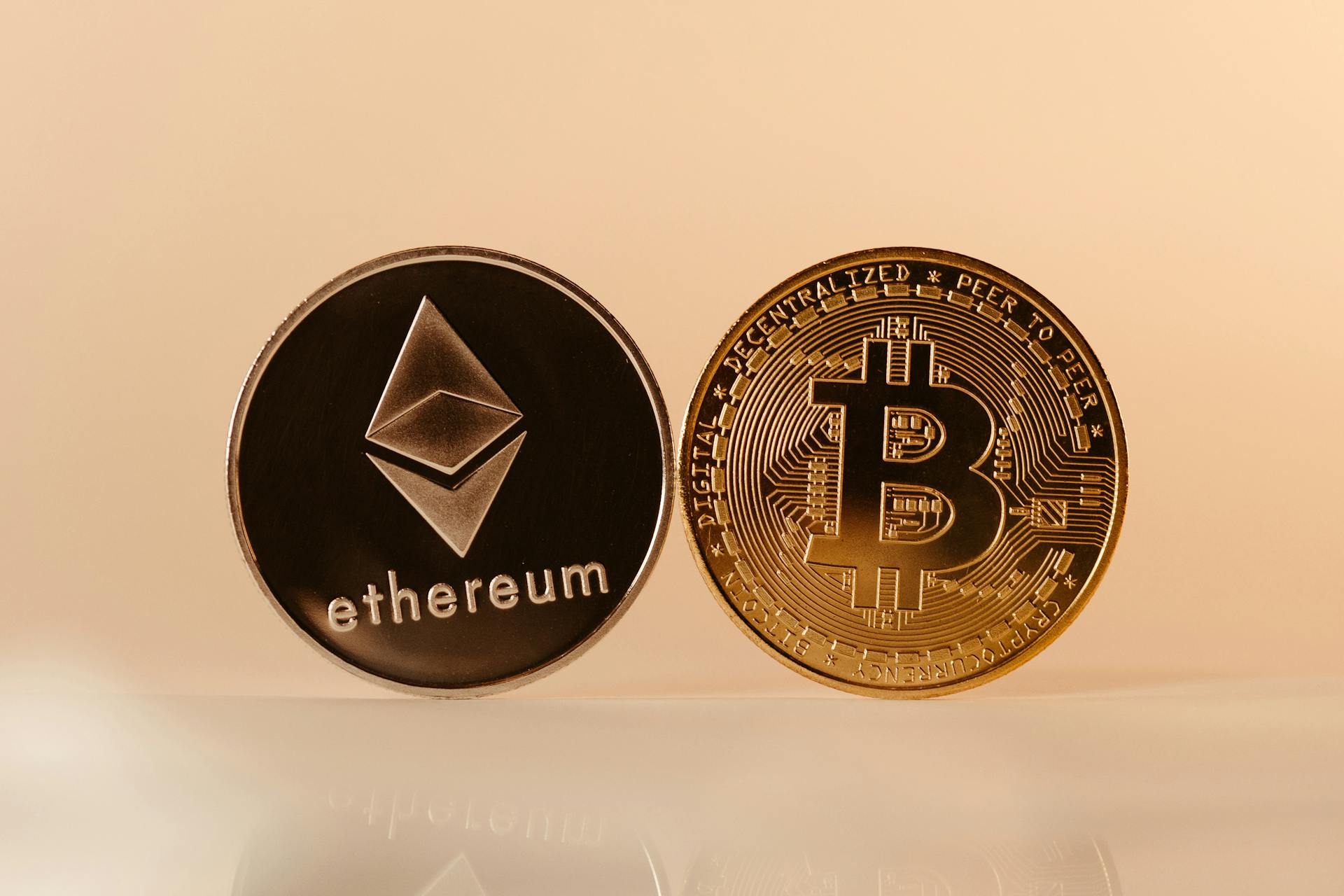
EVM compatible blockchains are designed to work seamlessly with the Ethereum Virtual Machine (EVM), allowing developers to deploy smart contracts and decentralized applications (dApps) that are compatible with the Ethereum network.
This compatibility is made possible by the EVM's open-source nature, which enables other blockchain platforms to adopt and modify the EVM's code to suit their needs.
EVM compatible blockchains can run Ethereum-based smart contracts, making it easier for developers to build and deploy applications across different networks.
By leveraging the EVM's existing ecosystem and tooling, EVM compatible blockchains can reduce the development time and costs associated with building custom blockchain solutions.
Recommended read: Applications of Blockchain
What Does 'EVM' Mean?
The EVM, or Ethereum Virtual Machine, is a crucial component of the Ethereum ecosystem. It's responsible for executing Ethereum smart contracts.
EVM compatibility is a key feature of many blockchains, allowing them to run the EVM and execute Ethereum smart contracts. This means developers can write and deploy the same smart contracts across multiple EVM blockchains.
You might like: Smart Contract Definition
The EVM is not a physical machine, but rather a software layer that enables the execution of smart contracts. It's a fundamental building block of the Ethereum ecosystem.
EVM-compatible blockchains can interact with other EVM-compatible blockchains through the EVM, enabling the creation of multi-chain dApps. This is a major advantage of EVM compatibility.
The EVM is a key enabler of the Ethereum ecosystem's tools, technical upgrades, and user base. This is why EVM compatibility is a highly sought-after feature in many blockchains.
Expand your knowledge: Ethereum Smart Contract
How It Works
The EVM is a Turing-complete virtual machine, capable of executing any algorithm or program, which gives Ethereum its programmability.
This allows developers to write complex smart contracts and build dApps on top of the Ethereum network. Deterministic execution is a powerful feature of the EVM, meaning that any given smart contract will always produce the same output for the same input.
This determinism is essential for the consensus mechanism of the Ethereum network, which requires all nodes to agree on the state of the network. The EVM is also designed to be isolated from the rest of the computer's operating system, ensuring security and protecting the network from attacks.
Smart contracts are executed within the EVM environment, providing a secure sandbox for the code to run in. This isolation means that the EVM can only interact with the Ethereum network, preventing malicious actors from accessing the underlying system or compromising the security of the network.
For another approach, see: Telegram Open Network News
EVM Features and Benefits
EVM features make it a crucial component of web3 development. The EVM is Turing-complete, meaning any node on the network can execute smart contracts or compute transactions.
One of the key features of the EVM is its opcode, which makes up the bytecode and dictates the operations that the EVM must perform. This allows for the execution of complex smart contracts with intricate logic and calculations.
EVM-compatible blockchains have several benefits, including portability and interoperability. Smart contracts and dApps developed for one EVM-compatible chain can be easily migrated to other EVM-compatible chains with minimal code modifications.
Here are some of the main features of EVM-compatible blockchains:
- Smart Contract Execution: The EVM allows for the execution of smart contracts, which are self-executing digital agreements that can be programmed with conditions and automatically execute when those conditions are met.
- Turing Completeness: The EVM supports a concept known as "Turing completeness" which means that its code can perform any computation that a Turing machine can.
- Gas Model: EVM-compatible blockchains operate on a "gas" model where each operation or instruction in the code requires a certain amount of gas to be executed.
- Interoperability: As EVM is a widely used virtual machine, it allows for interoperability between different blockchain networks.
- Flexibility: Due to its open source nature, the EVM is constantly evolving with new updates and improvements being made regularly.
- Decentralized Applications: With the ability to execute smart contracts, developers can build DApps on top of EVM-compatible blockchains.
- Compatibility with Ethereum Ecosystem: As EVM is the virtual machine used on the Ethereum blockchain, all tools, libraries, and frameworks developed for Ethereum can also be used on EVM-compatible blockchains.
- Security: EVM-compatible blockchains inherit the security features of the Ethereum network, including its robust hashing algorithm and use of public-key cryptography.
- Scalability: With advancements in layer 2 solutions such as side chains and state channels, EVM-compatible blockchains have become more scalable while maintaining compatibility with Ethereum's ecosystem.
EVM Compatible Blockchains
EVM compatible blockchains offer a wide range of opportunities for developers to build decentralized applications and launch new digital assets. They are a group of decentralized blockchain platforms that support the execution of smart contracts developed in the Ethereum Virtual Machine (EVM) programming language.
Scalability is a crucial factor to consider when selecting an EVM compatible blockchain, as it affects the ability of the blockchain to handle a large number of transactions without slowing down or becoming congested. Some popular EVM compatible blockchains include Polygon, Binance Smart Chain (BSC), Arbitrum, Avalanche, and Optimism.
Here are some of the top 5 EVM compatible blockchains:
These EVM compatible blockchains offer a range of benefits, including portability and interoperability, lower costs, and a broader user base and developer ecosystem. By considering these factors and choosing the right EVM compatible blockchain for your project, you can ensure the success and scalability of your decentralized application.
Popular EVM Blockchains
EVM compatible blockchains have made it easier for developers to build and deploy decentralized applications (dApps) across different networks. One of the most popular EVM blockchains is Ethereum, which has a massive developer community and is the backbone of the Ethereum network.
A unique perspective: Ethereum Eth
Polygon is another EVM-compatible blockchain that facilitates horizontal scalability by helping build Ethereum-compatible chains and interconnecting them. It's also amping up zkEVM efforts using both ZK and optimistic rollups.
Binance Smart Chain (BSC) is a high-performance blockchain that is EVM compatible, primarily designed for decentralized trading and efficient smart contract execution. It's a popular choice for developers looking to build dApps on a fast and scalable blockchain.
Arbitrum is a layer 2 scaling solution that employs optimistic rollups to enhance Ethereum's throughput while reducing costs. It's a great option for developers who want to build dApps on a blockchain that is both fast and secure.
Avalanche is a highly scalable blockchain that runs on the Avalanche consensus protocol, offering near-instant transaction finality. It's also EVM compatible, making it a great choice for developers who want to build dApps on a blockchain that is both fast and secure.
Optimism is a layer 2 scaling solution that uses optimistic rollups to process more transactions with faster finality, reducing Ethereum congestion. It's a great option for developers who want to build dApps on a blockchain that is both fast and secure.
Discover more: What Is Avalanche Blockchain
Here are some of the top EVM-compatible blockchains, in no particular order:
- Polygon
- Binance Smart Chain (BSC)
- Arbitrum
- Avalanche
- Optimism
- Harmony (ONE)
These blockchains offer a range of benefits, including interoperability, a large developer community, and familiar programming languages. They also provide a seamless integration with existing dApps built on Ethereum, making it easier for developers to build and deploy decentralized applications across different networks.
Supply Chain Finance
Supply Chain Finance is a game-changer for businesses, enabling decentralized financing solutions for supply chain management.
These solutions can help companies like yours access much-needed funds to purchase inventory, manage cash flow, and stay competitive in the market.
Invoice factoring is a popular example of Supply Chain Finance, allowing businesses to receive immediate payment for outstanding invoices.
Trade finance is another key use case, providing financing for international trade and helping companies navigate complex global supply chains.
Inventory financing is also becoming increasingly important, giving businesses the flexibility to manage their inventory levels and reduce stockouts.
A fresh viewpoint: Smart Contract Solutions
Building on EVM
Building on EVM is now easier than ever, thanks to frameworks like thirdweb that support all EVM-compatible networks. With their best-in-class development kit, developers can create new smart contracts or import existing ones to build dApps on any EVM-compatible blockchain.
Thirdweb's development kit includes SDKs for popular programming languages like React, JavaScript, Unity, Python, and Go, making it accessible to a wide range of developers. They also offer a decentralized storage service, plug-and-play UI components, and an intuitive dashboard to manage contracts in one place.
Developers can now build, launch, and manage all their smart contracts and web3 apps in one place, making it a game-changer for the industry.
Recommended read: Defi Smart Contract Development
Solidity > Bytecode > Opcode
Building on the Ethereum Virtual Machine (EVM) requires a solid understanding of the code translation process. Developers use Solidity to write smart contract logic, which is then compiled into bytecode.
Solidity is a high-level programming language that's similar to JavaScript, making it easier for web2 developers to onboard. This means you can leverage your existing coding skills to create smart contracts.
The EVM reads bytecode and breaks it down into a series of opcodes, short for operation code. Each opcode is a specific instruction that tells the EVM what operation to perform.
Here's a brief overview of the code translation process:
- Solidity code is compiled into bytecode.
- Bytecode is then broken down into opcodes by the EVM.
Understanding this process is crucial for building and deploying smart contracts on the EVM. By mastering the Solidity > bytecode > opcode flow, you'll be well on your way to creating efficient and effective smart contracts.
Readers also liked: What Are Smart Contracts Blockchain
Building a Dapp
Building a dapp on EVM-compatible blockchains is now easier than ever, thanks to thirdweb's universal web3 framework. This framework supports all EVM-compatible networks and has gone from supporting 7 blockchains to 700+, making it a game-changer for developers.
You can create new smart contracts or import your own existing ones to build dApps on any EVM-compatible blockchain using thirdweb's best-in-class development kit. This kit includes SDKs for popular programming languages like React, JavaScript, Unity, Python, and Go.
Readers also liked: Co-founder Animoca Brands - Yat Siu
The development kit also provides a decentralized storage service that uploads and pins files to IPFS for you, making it easy to manage and store your data. Additionally, it comes with plug-and-play UI components for frontend applications and an intuitive dashboard to manage all your contracts in one place.
Here are some of the key features of thirdweb's development kit:
- SDKs for React, JavaScript, Unity, Python, and Go
- Decentralized storage service that uploads and pins files to IPFS
- Plug-and-play UI components for frontend applications
- Intuitive dashboard to manage all your contracts in one place
With thirdweb, developers can build, launch, and manage all of their smart contracts and web3 apps in one place. This makes it easier to create and deploy decentralized applications without having to worry about the underlying infrastructure.
EVM and Web3
EVM-compatibility is a fundamental driver in making web3 accessible to everyone, not just tech-savvy individuals. This is because it accelerates innovation and brings all users on the same and leveled playing field.
EVM compatibility makes lives easier for developers by allowing them to code and build dapps once and easily deploy them across all compatible blockchains. This portability saves time and resources, as there's no need to rewrite contracts for different networks.
The interoperability offered by EVM compatibility reduces the learning curve for developers, making it easier for them to adapt to the nuances of blockchain development. This is especially true for Web2 developers transitioning to Web3.
EVM-compatible blockchains offer tools and resources that ease the transition for Web2 developers into the Web3 space. By providing comprehensive documentation, developer support communities, and compatibility layers, EVM blockchains can help Web2 developers leverage their existing skills.
The state transition function of the EVM ensures that all state changes are consistently updated and broadcast to all the nodes in the network. This makes Ethereum more predictable and reliable, and is a key element of web3 development.
EVM-compatible chains leverage the same EVM bytecode and support the same programming languages, such as Solidity, as Ethereum. This makes it easy for developers familiar with Ethereum to transition and build on these blockchains without learning new languages or tools.
Guide to EVM Use Cases
EVM compatible blockchains are versatile and can be used in a variety of ways. Some of the use cases of EVM compatible blockchains include:
Decentralized finance (DeFi) applications are a key use case for EVM compatible blockchains, as they can run smart contracts and provide financial services to users.
EVM compatible blockchains can also be used for non-fungible token (NFT) creation and trading, allowing artists and creators to mint and sell unique digital assets.
Game development is another use case for EVM compatible blockchains, enabling the creation of decentralized games with blockchain-based economies and token rewards.
You might like: Do All Cryptocurrencies Use Blockchain
Choosing an EVM Blockchain
Scalability is a major concern for popular EVM-compatible blockchains like Ethereum, which is why it's crucial to select a blockchain that has implemented or has plans to implement solutions for scalability, such as sharding or layer-2 scaling solutions like Plasma or state channels.
Network activity and adoption can greatly impact a blockchain's value and potential success, so look for projects with a large community, active development, and significant use cases.
Interoperability is also key, as it allows developers to create DApps that can interact with different blockchains easily. Consider platforms that have collaborations with other compatible chains or have plans for cross-chain communication capabilities.
Governance mechanisms play a crucial role in decision-making processes within a blockchain network, so choose one with effective governance procedures in place, ensuring transparency and fairness.
Security should be a top priority when selecting an EVM-compatible blockchain, with robust security measures such as regular security audits and bug bounty tools.
Developers should look for platforms with comprehensive developer resources, including development tools, programming languages support, documentation, and tutorials.
Here are the key factors to consider when selecting an EVM-compatible blockchain:
- Scalability: Look for implemented or planned solutions for scalability, such as sharding or layer-2 scaling solutions.
- Network Activity and Adoption: Choose a project with a large community, active development, and significant use cases.
- Interoperability: Consider platforms with collaborations or plans for cross-chain communication capabilities.
- Governance: Select a blockchain with effective governance procedures in place.
- Security: Ensure robust security measures, such as regular security audits and bug bounty tools.
- Developer Tools and Support: Look for comprehensive developer resources, including development tools and tutorials.
Sources
- https://blog.thirdweb.com/evm-compatible-blockchains-and-ethereum-virtual-machine/
- https://blog.quicknode.com/web3-development-evm-compatible-blockchains-101/
- https://shardeum.org/blog/what-are-evm-compatible-blockchains/
- https://sourceforge.net/software/evm-compatible-blockchains/
- https://blockworks.co/news/sonic-labs-unveils-sonic-mainnet-the-future-of-fast-evm-compatible-blockchains
Featured Images: pexels.com


